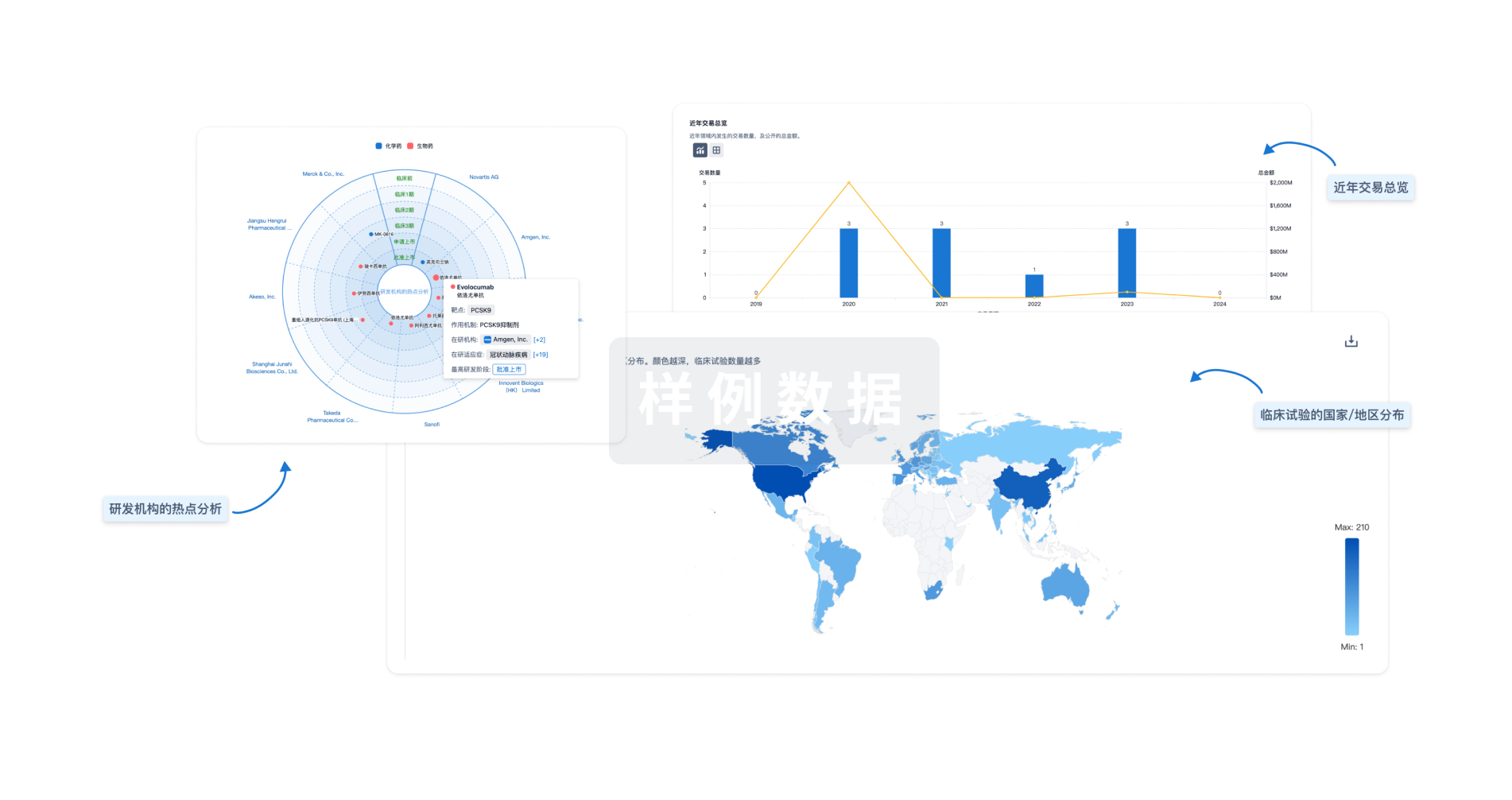预约演示
更新于:2025-05-07
VCAM1 x Integrin
更新于:2025-05-07
关联
100 项与 VCAM1 x Integrin 相关的临床结果
登录后查看更多信息
100 项与 VCAM1 x Integrin 相关的转化医学
登录后查看更多信息
0 项与 VCAM1 x Integrin 相关的专利(医药)
登录后查看更多信息
2,037
项与 VCAM1 x Integrin 相关的文献(医药)2025-04-01·Journal of Biomedical Materials Research Part A
Dual‐Functional Peptide DPI ‐VTK Promotes Mesenchymal Stem Cell Migration for Bone Regeneration
Article
作者: Kohn, David H. ; Wahlsten, Madison ; Calabrese, Tia C. ; Madsen, Eric J. ; Rhee, Seungmeen
2025-04-01·Journal of Lipid Research
Foamy monocytes and atherogenesis in mice with combined hyperlipidemia and effects of antisense knockdown of apoCIII
Article
作者: Peng, Xueying ; Dong, Henry ; Xu, Lu ; Xiao, Jing ; Ni, Jing ; Mullick, Adam E ; Pownall, Henry J ; O'Brien, Veronica ; Perrard, Xiao-Yuan Dai ; Mukherjee, Aparna ; Ballantyne, Christie M ; Litchfield, Benjamin A ; Simmons, Timothy ; Crooke, Rosanne ; Simon, Scott I ; Wu, Huaizhu ; Lian, Zeqin
2025-04-01·Human Gene Therapy
Overexpression of ABCA1 in Carotid Endothelium of Hyperlipidemic Rabbits Modulates Vascular Inflammation
Article
作者: Wacker, Bradley K. ; Sanford, Nicole ; Regan, Abigail Z. ; Dichek, David A. ; Bi, Lianxiang ; Liu, Li ; Saenz-Pipaon, Goren ; Lim, Natalie S. ; Kim, Francis
15
项与 VCAM1 x Integrin 相关的新闻(医药)2024-10-30
·赞Med
点击上方“蓝字”关注我们吧!
呼吸道合胞病毒(RSV)是儿童急性呼吸道感染的主要病因之一,暴露于包括香烟烟雾、颗粒物、苯、臭氧(O3)、一氧化碳(CO)或二氧化氮(NO2)在内的空气污染则可能增加RSV发病率和严重程度。世界卫生组织(WHO)已公布六种最重要的空气污染物清单,包括颗粒物≤直径10μm的颗粒物(PM10)、直径在0.1至2.5μm之间的颗粒物(PM2.5)、NO2、O3、二氧化硫(SO2)和CO。
目前关于RSV和空气污染的确切病理机制数据较少,主要结论集中在宿主抗病毒能力下降、促进病毒进入和病毒载量增加、病毒从主要感染细胞释放增加、炎症反应延长和/或加重(可能导致组织病理改变,粘液分泌增强和气道高反应(AHR)),其中最重要的共同机制之一似乎由氧化应激所介导。
N-乙酰半胱氨酸(NAC)作为一种具有抗氧化和抗炎特性的粘液溶解药物,已广泛应用于慢性阻塞性肺疾病(COPD)、支气管扩张症、特发性肺纤维化等临床研究中。一篇发布在《International Journal of Molecular Sciences》(IF=4.9)的系统综述回顾现有文献以确定NAC在治疗RSV感染和空气污染中的分子作用机制[1]。
研究设计
研究者对Scopus、PubMed(Medline)和Cochrane数据库进行了系统的文献检索,检索数据库中1998年至2023年9月7日期间所有分析NAC在RSV感染或空气污染中的分子作用机制的原始研究。共检索出167项研究,去重后,根据摘要和标题排除了122项研究,阅读全文最后筛选出28项原始研究纳入系统综述。
研究结果
NAC可减少病毒进入
空气污染主要通过两种机制促进病毒进入:
(1)损伤保护屏障(由于现有屏障受损或存在额外的运输通道);
(2)病毒吸附增加(由于细胞表面的变化促进病毒粘附,或RSV获得特殊毒力,从而促进其粘附到细胞表面或进入),但暂未发现关于RSV毒力增加的信息(图1)。
①NAC可改善上皮屏障通透性
Smallcombe等人在人支气管上皮细胞和小鼠模型中证明,TiO2-NP通过破坏顶端连接复合物(AJC)和重塑细胞内细胞骨架肌动蛋白对AJC的锚定以增强RSV诱导的上皮屏障瓦解,使上皮变得“渗漏”,从而增强病毒感染。通过评估病毒降低滴度,NAC治疗减少了AJC分解,改善了上皮通透性,降低了RSV感染程度。
氧化应激在其中扮演着不容忽视的作用,研究发现共暴露于RSV和TiO2-NP后细胞内活性氧(ROS)水平迅速增加,并保持高水平长达36小时;Wen等人的研究证实暴露于TiO2-NP后过氧化氢酶(CAT)活性增加,ROS上调,许多细胞间隙和内皮层通透性增加,内皮钙黏蛋白(VE-cadherin)表达降低,而NAC的使用逆转了氧化应激和间隙的形成,表明其在氧化应激中发挥关键作用。
②NAC可抑制血清细胞间粘附分子1(ICAM-1)表达
ICAM-1是一种存在于多种细胞表面的糖蛋白,包括上皮细胞和内皮细胞、淋巴细胞和单核细胞,RSV感染诱导人内皮细胞上ICAM-1表达呈时间和剂量依赖性过度增加。
Mata等研究表明,在RSV培养的原代正常人支气管上皮细胞(NHBEC)中,使用NAC预处理可消除ICAM-1表达增加现象;Modestou等人发现香烟烟雾提取物抑制干扰素-γ(IFN-γ)诱导的人器官支气管上皮细胞(hTBE)中ICAM-1的表达,但NAC和谷胱甘肽单乙基酯(GSH-MEE)能够减轻这种抑制作用。
除ICAM-1外,空气污染还可能诱导其他表面分子表达:TiO2-NP诱导内皮细胞中ICAM-1、血管细胞间黏附分子1(VCAM-1)、血小板内皮细胞黏附分子(PECAM-1)和选择素(E和P)的表达,以及它们在单核细胞上的配体包括早期[E-选择素配体(sLex)和P-选择素配体(PSGL-1)]和晚期粘附分子[ICAM-1配体(LFA-1)、VCAM-1配体(VLA-4)和PECAM-1配体(αVβ3)]的受体表达,而NAC可抑制表面受体的表达。
③NAC可阻断表皮生长因子受体(EGFR)磷酸化
RSV进入细胞的另一种机制涉及EGFR的磷酸化和激活以及与EGFR相关信号因子的级联反应(PI3K、PKC、Cdc42、PAK1和N-Wasp)。RSV与细胞表面结合即激活EGFR的磷酸化及其下游信号级联,通过微胞饮作用引起肌动蛋白重排和内吞。NAC可阻断人支气管上皮细胞(HBECS)中EGFR的磷酸化,从而阻止病毒的内吞作用并减少感染。
NAC可抑制病毒载量增加
病毒载量增加可能源于宿主抗病毒反应降低、感染开始后RSV释放加速(通过促进从主要感染细胞释放)或由于RSV获得异常毒力(图2)。
①NAC可恢复抗病毒反应
人T细胞和自然杀伤(NK)细胞具有产生IFN-γ的能力,IFN-γ与其受体结合,并通过磷酸化Stat1导致Janus激酶/信号转导和转录激活因子(JAK/STAT)通路激活,二聚磷酸化的Stat1随后易位到细胞核并激活抗病毒基因。香烟烟雾提取物(CSE)抑制Stat1的磷酸化,并抑制IFN-γ介导的RSV mRNA和RSV蛋白表达降低,而使用NAC或GSH-MEE可恢复IFN-γ的抗病毒作用。
②NAC可抑制病毒释放
在暴露于CSE和RSV的hTBE细胞中观察到较高的病毒载量似乎与香烟烟雾可能阻止RSV诱导的caspase激活有关。在受CSE和RSV侵袭的细胞中,坏死比凋亡更明显,这导致病毒从感染细胞中释放出来,而不是凋亡。
一系列实验表明,使用NAC和醛脱氢酶能够部分逆转上皮细胞从凋亡到坏死的转变,这表明ROS和丙烯醛在这一复杂系统中发挥了重要作用。细胞模型显示,无香烟烟雾暴露的RSV也会产生ROS,并激活蛋白激酶/哺乳动物雷帕霉素靶点(AMPK-MTOR)信号通路,从而诱导自噬,促进病毒感染。敲除自噬基因(如beclin1)或用AMPK抑制剂(化合物C)或NAC治疗能够抑制RSV复制,但化合物C仅能阻断自噬依赖性RSV复制,NAC则具有抑制自噬依赖性和自噬非依赖性途径的能力。
Zhou等人的研究将细胞凋亡标志物的评估与临床角度相结合,在126例老年慢性阻塞性肺疾病(COPD)患者中采用口服NAC、吸入硫酸特布他林和两者联合三种治疗方法。所有治疗方案均可降低Fas受体/凋亡抗原1(Fas/APO-1)和可溶性Fas(sFas)水平,改善氧化还原状态,即ROS降低、氧化应激指标丙二醛(MDA)降低,并伴有超氧化物歧化酶(SOD)和谷胱甘肽过氧化物酶(GSH-PX)升高,且两药合用效果最佳。
NAC可减轻过度的宿主反应
①NAC可减轻过度的促炎反应
A. NAC可减少促炎趋化因子和细胞因子的产生
许多促炎趋化因子和细胞因子被认为与RSV感染和空气污染共同暴露后的强烈的免疫反应有关,具有广泛数据支持的包括白细胞介素-6(IL-6)、白细胞介素-8(IL-8)、白细胞介素-17(IL-17)、肿瘤坏死因子(TNF-α)、单核细胞趋化蛋白-1(MCP-1)的作用,以及在激活后调节的正常T细胞表达和分泌(RANTES)(图3)。
Lei Chi等人的研究证实了NAC的抗炎作用:NAC处理后细胞上清液中mRNA表达和细胞因子浓度(TNF-α、IL-6、IL-1β和IL-18)均显著降低;Mata等人的研究也表明NAC抑制IL-6、IL-8和TNF-α的表达;在苯并[a]芘引起的急性肺损伤小鼠模型中,NAC预处理能够减轻炎症反应,降低TNF-α、IL-6、MCP-1、MIP-2(巨噬细胞炎症蛋白2,Cxcl2)基因的表达。
B.NAC可降低NF-κB刺激作用
Carpenter证明了NAC抑制RSV诱导的趋化因子表达的方式与TNF-α不同,提示氧化还原敏感的NF-κB通路参与了IL-8、MCP-1和RANTES的诱导。
当HBEC(BEAS-2B)、正常人支气管上皮(NHBE)和COPD人支气管上皮(DHBE)细胞暴露于PM2.5后,NF-κB靶细胞因子的结合活性和分泌均表现出剂量依赖性增加。长时间暴露于PM2.5会导致核因子-红细胞2p45相关因子2(NRF2)信号通路部分失活,破坏线粒体氧化还原稳态。NRF2/Kelch样环氧氯丙烷相关蛋白1(KEAP-1)是抗氧化反应的关键调节因子,KEAP1释放NRF2导致其蛋白体降解,从而刺激包括血红素加氧酶1(HO1)基因在内的NRF2靶基因产生抗氧化作用。
Mata等人的研究描述了NAC作用诱导的抗氧化机制:感染RSV后第15天HO1表达下降,NAC预处理后HO1表达不仅恢复且升高。由于NRF2本身表现出复杂的时变反应,RSV感染后,总抗氧化状态(TAS)即细胞对氧化事件的反应能力下降,使用1mM NAC预处理恢复,使用10mM NAC预处理后增加。此外,NAC能够抑制NF-κB向细胞核的易位以及p38/丝裂原活化蛋白激酶(MAPK)的磷酸化以调节NRF2的表达。
IL-8和RANTES的产生均受柴油尾气颗粒诱导,p38/MAPK磷酸化在HBECs中起关键作用,NAC预处理不仅降低了p38 MAPK磷酸化酪氨酸和苏氨酸的数量,也因此降低了IL-8和RANTES的浓度。MAPK信号通路包括三个信号通路:细胞外信号相关激酶(ERK)、Jun氨基末端激酶(JNK)和p38,它们将信号从细胞膜传递到细胞核,Wang等人使用细胞(HBECs)和动物(小鼠)模型进行的一项研究表明,在暴露于颗粒物之前使用NAC预处理可阻断ERK、JNK和p38的磷酸化。
C.NAC可阻止或减少氧化应激
氧化应激在RSV和空气污染的相互作用中起着至关重要的作用,NAC可有效阻止或减少氧化应激的危害。RSV感染HBECs模型(BEAS-2B)显示,RSV诱导ROS和MDA的产生,SOD活性和细胞内还原型谷胱甘肽/氧化型谷胱甘肽(GSH/GSSG)比值。NAC处理可抑制ROS和MDA的产生,提高SOD活性和GSH/GSSG比值,从而减弱RSV感染的病理效应。柴油尾气暴露的体外模型表明,NAC具有恢复细胞内GSH/GSSG比值、抵消脂质和蛋白质氧化、抑制氧化应激诱导的HO-1表达的能力。
在人体和动物模型中,颗粒物均可诱导ROS以剂量和时间依赖的方式产生,而NAC预处理能够阻断ROS的产生;缺氧-再氧化应激通过增加ROS的产生对人上皮细胞造成损伤,NAC可有效缓解该现象;此外,RSV感染会增加热休克70kDa蛋白6(HSPA6),而NAC可有效阻断HSPA6 mRNA和蛋白表达。
D.NAC可减轻病原相关分子模式(PAMP)激活带来的影响
toll样受体(TLRs)是膜结合的模式识别受体(PRRs),TLR3、TLR7、TLR8和TLR9识别特定的病毒基因组成分,并在病毒诱导的信号转导中发挥关键作用。Wang等人的研究证实了人肺上皮A549细胞中TLR3的激活与氧化应激之间存在相关性。
RSV感染细胞羟基自由基(·OH)和一氧化氮(NO)浓度升高,SOD总活性降低,NAC预处理可降低这些影响,并且·OH和NO水平均与RSV感染持续时间呈时间依赖性;在mRNA表达方面,RSV感染后TLR3和NF-κB上调,干扰素调节因子-3(IRF3)和超氧化物歧化酶1(SOD1)基因下调,NAC预处理可逆转mRNA和蛋白的表达模式,提示氧化应激可能在TLR3激活和炎症反应增强中起调节作用。
②NAC可抑制过度的粘液分泌
RSV感染和空气污染(如香烟烟雾)可能增加粘液分泌,MUC5AC作为一种形成凝胶的粘蛋白,是人类粘液的主要成分之一,Mata等人的研究表明,NAC能够抑制粘蛋白基因MUC5AC的释放。
③NAC可改善肺部结构异常
在慢性鼻窦炎或COPD等病理条件下,杯状细胞化生和MUC5AC表达增加,而香烟烟雾增强了病理反应,这主要是由EGFR通路介导的。Mata等人研究发现,感染RSV的NHBECs的纤毛阳性和β管蛋白阳性细胞数量下降,并伴有轴突基底体超微结构异常,而NAC能够以剂量依赖的方式抑制上调,恢复上皮功能;Lei Chi等人的研究也表明,在人HBECs(BEAS-2B细胞)中,NAC处理抑制了EGFR的磷酸化和MUC5AC的激活。
大鼠肺支气管肺泡灌洗(BAL)表现为高浓度环境颗粒引起的多形核白细胞内流,并伴有细支气管血管增厚、细支气管炎症和肺水肿等组织病理改变,NAC预处理逆转了多形核白细胞内流,动物无组织学变化。此外,NAC预处理可逆转小鼠肺部颗粒物诱导的PM沉积周围炎症细胞浸润,减少支气管肺泡灌洗液(BALF)中中性粒细胞和巨噬细胞数量,提高肺损伤评分。
④NAC可减轻肺气肿
Cai等研究显示NAC可减轻吸烟致COPD大鼠晚期肺气肿,NAC处理大鼠的平均线性截距(MLI)和破坏指数(DI)均较低。重要的是,NAC降低了肺泡间隔细胞的凋亡指数(AI),逆转了血管内皮生长因子(VEGF)及其受体蛋白(VEGFR2)表达的下降,AI与VEGF水平呈负相关。苯并[a]芘引起的小鼠组织病理学改变包括气道壁增厚,MLI减少,DI增加,经NAC预处理后均有缓解,肺病理总评分均有改善。
另一种小鼠模型研究了臭氧诱导的COPD,并比较了NAC的预防和治疗作用,结果显示,暴露前给予NAC能够减少BAL和气道平滑肌(ASM)肿块中的巨噬细胞数量,而治疗性给药能够减少ASM肿块和凋亡细胞数量,但肺气肿不可逆。肺气肿的机制复杂,与基质金属蛋白酶(MMP)尤其是MMP-9和MMP-12相关,在颗粒物暴露模型中,NAC预处理后HBECs和BALF中MMP-9的表达和水平均降低。
⑤NAC可减轻DNA损伤和衰老
氧化应激诱导DNA损伤,并可能引发细胞衰老(增殖停止),这已在RSV感染中得到证实。RSV感染后,ROS产生增加,DNA损伤和增殖阻滞标志物表达增加,而NAC可显著减少受损细胞核的数量,但其保护作用仅对新生DNA损伤灶有效,对先前存在的DNA损伤灶几乎无效。
各种空气污染物包括颗粒物(PM2.5、PM10)、NO或香烟烟雾对衰老和细胞衰老也有类似的影响,而氧化应激则是最合理的相互作用机制。Kang等人研究证实NAC预处理可逆转空气污染物对ROS生成和DNA断裂的影响,在防止DNA损伤和细胞衰老方面发挥保护作用。
NAC可降低气道高反应(AHR)
混合暴露于RSV和空气污染可导致RANTES、MCP-1和NGF水平升高,白血病抑制因子(LIF)水平降低,从而导致AHR,而上述研究证明了NAC在RSV暴露和空气污染暴露(分别为柴油排放和苯并芘)模型中降低RANTES和MCP-1水平的有效性,这可能进一步导致AHR降低或消失。
· 总结 ·
本综述确定了NAC用于减轻RSV感染和空气污染影响的潜在分子机制,包括阻断病毒进入、降低病毒载量和过度的宿主反应(炎症反应增强、粘液分泌增加、AHR、DNA损伤和/或细胞衰老)等。未来应开展进一步研究以调查RSV感染期间NAC的作用,并重点关注NAC在最重要的六种空气污染物中发挥的分子机制。
参考文献
[1]Wrotek A, Badyda A, Jackowska T. Molecular Mechanisms of N-Acetylcysteine in RSV Infections and Air Pollution-Induced Alterations: A Scoping Review. Int J Mol Sci. 2024,25(11):6051.
提示:本材料仅供医疗卫生专业人士进行医学科学交流,不用于推广目的。
临床研究
2024-09-30
来源:小药说药
前言
人类基因组的破译加上生物技术的进步,特别是单克隆抗体(mAbs)的里程碑式发现,使得生物治疗极大地改善了病人的生存时间和生存状态。目前,已经有超过300种生物疗法获得美国食品和药物管理局(FDA)批准,其中许多被批准用于治疗免疫和炎症性疾病。
2022年全球TOP100畅销药合计实现了4868亿美元的销售收入,自免疾病领域已经是仅次于肿瘤的第二大药物市场。跻身TOP100榜单的自免产品共18款,总金额达861.7亿美元。如今,自免领域已成为重磅炸弹的密集诞生地,也成为各大制药巨头业绩贡献的主要来源。
治疗靶点与开发药物
下表列出了经FDA批准用于自身免疫疾病适应症,以及处于关键3期临床试验或阳性的2期临床试验中的生物疗法。
白细胞介素-1
IL-1α和IL-1β定位于对无菌状态下和微生物介导的炎症反应的迅速响应。当上皮细胞、内皮细胞和血小板对组织损伤作出反应时,IL-1α作为一种报警素发挥作用。相反,髓系来源的亚型IL-1β是作为一种非活性蛋白合成的,需要炎症小体驱动的蛋白水解过程才能发挥活性。IL-1α/β属于较大的IL-1细胞因子家族,它利用IL-1受体辅蛋白(IL-1RAcP)与IL-1R1亚基配对产生MyD88依赖性信号。IL-1α/β功能也受天然拮抗剂IL-1Ra、sIL-1RAcp和诱饵受体IL-1R2的调控。IL-1α/β表达失调与以发热、皮疹、关节炎和器官特异性炎症为特征的多种全身性自身炎症性疾病(SAID)有关。
FDA已经批准了三种不同性质的生物疗法,但都是针对IL-1的。Anakinra是一种天然拮抗剂IL-1Ra的改良版本,它同时抑制IL-1α和IL-1β。Anakinra被批准用于治疗RA和CAPS,其半衰期短,为5-6小时,因此需要每天皮下注射。Anakinra对痛风也有效,尿酸单钠晶体刺激NLRP3激活和IL-1β产生。Canakinumab是一种IL-1β中和抗体,每4-8周皮下给药一次,被批准用于治疗全身性青少年特发性关节炎(SJIA)和SAIDs。Rilonacept编码IL-1R和IL-1AcP的胞外结构域,与IgG的Fc部分相连,优先中和IL-1β,批准用于SAIDs的每周皮下给药。
白细胞介素-6
IL-6是gp130细胞因子家族的一员,是许多稳态和炎症过程的中心组成部分。IL-6最初被鉴定为促进B细胞分化的T细胞衍生因子,现在因其在适应性免疫中的多效性活性而受到重视。它有助于Th17和T滤泡辅助细胞(Tfh)的分化,驱动髓样细胞分化,并与Th2细胞因子协同促进巨噬细胞极化为促纤维化表型。IL-6在肝脏急性期反应中起重要作用,增加包括C反应蛋白(CRP)在内的炎症蛋白,增强补体与病原体或死亡细胞的结合,对内皮细胞功能和上皮细胞完整性也有重要影响。
IL-6的广泛生物活性源于其调节多个细胞靶点的复杂性质。IL-6由多种细胞合成,并通过三种不同的细胞表面信号机制(即经典信号、反式信号和反式呈递)激活靶细胞,最终产生JAK/STAT信号。
Tocilizumab和sarilumab是FDA批准的两种IL-6R阻断性单抗,许多其他药物正在临床开发中。Tocilizumab和sarilumab被FDA批准用于治疗中重度RA,其中受影响关节滑液中IL-6水平升高,血清IL-6水平与疾病活动相关。这两种药物都能改善RA患者的炎症症状并减少影像学进展。
细胞因子释放综合征(CRS)是一种急性全身炎症性疾病,与许多基于抗体的治疗、化疗和T细胞参与的免疫治疗(如CAR-T细胞)以及严重感染相关。与T细胞参与疗法相关的CRS被认为是由活化的T细胞产生TNF-α,进而触发单核细胞和活化的巨噬细胞产生IL-6和IL-1β。CRS症状(例如发烧和低血压)的缓解通常在单剂量的Tocilizumab后实现。给药tocilizumab似乎并不影响T细胞参与疗法的抗肿瘤效果。
肿瘤坏死因子
TNF-α主要由免疫细胞和内皮细胞产生,并通过促炎信号和细菌产物显著上调;TNF-β(LTα)主要由淋巴细胞产生。TNF-α以三聚体膜结合形式(mTNF)表达并经历蛋白水解裂解产生可溶性三聚体sTNF。TNFR1广泛表达,而TNFR2主要表达于神经元、免疫细胞和内皮细胞。TNF-α具有多效性功能。TNF-α对病原体的最佳防御、淋巴器官的正常发育以及在神经元再髓鞘化、心脏重塑和软骨再生中的重要修复作用都是必需的。
目前有五种TNF抑制剂被FDA批准用于临床,全部都靶向TNF-α,其中依那西普另外抑制TNF-β。肿瘤坏死因子拮抗剂的分子类型反映了近二十年来生物治疗药物的发展。依那西普(TNFR2-Fc)是FDA批准的第一个Fc融合蛋白;infliximab是第一代嵌合单抗;adalimumab是来源于噬菌体展示的人源单抗;golimumab是来源于表达人IgG的转基因小鼠的人源单抗;certolizumab-pegol是一种从小鼠杂交瘤中分离的人源化Fab片段,经聚乙二醇化可延长其体内半衰期。
大多数肿瘤坏死因子拮抗剂显示出共同的临床疗效。然而,依那西普在克罗恩病(CD)的随机双盲安慰剂对照试验中无效,可能反映了TNF抑制剂治疗机制的差异。除了中和sTNF-α外,抗TNF抗体和certolizumab-pegol(而不是依那西普)可通过结合mTNF或阻断抗凋亡信号诱导固有层T细胞凋亡。此外,抗TNF单抗(而非依那西普或certolizumab-pegol)可通过Fc依赖机制诱导M2型创伤愈合巨噬细胞应答。因此,TNF拮抗剂之间的机制差异可能是导致其在CD中不同临床效果的原因。
CD20
CD20是一种B细胞标志物,其表达始于早期的前B细胞,但在向浆细胞的终末分化过程中丢失。它是一种四肽蛋白,是B细胞发挥最佳功能和免疫反应所必需的。
Rituximab是一种嵌合单抗,是FDA批准的第一种治疗B细胞非霍奇金淋巴瘤的抗CD20单抗。基于其在肿瘤学中令人惊讶的良好安全性,研究人员开始探索其在严重自身免疫性疾病患者中的应用。Rituximab目前被FDA批准用于治疗多种自身免疫性疾病。由于CD20既不在HSC上表达,也不在终末分化的浆细胞上表达,因此抗CD20单抗选择性靶向CD20+B细胞与先天性B细胞缺乏具有不同的免疫学后果。例如,用抗CD20抗体治疗后,血清IgG水平没有显著影响,而严重的X连锁无丙种球蛋白血症(其中B细胞不发育)则观察到缺乏免疫球蛋白。
最近的一项2期研究使用了obinutuzumab,一种具有增强ADCC和诱导B细胞凋亡能力的II型抗CD20单抗,已报道狼疮性肾炎患者的临床获益(NCT 02550652)。需要对obinutuzumab进行进一步的研究,以确认额外的B细胞消耗是否对狼疮性肾炎有益。
BAFF/APRIL肿瘤坏死因子超家族成员
BAFF和APRIL是TNF配体超家族的两种II型跨膜蛋白,它们的受体BAFFR、BCMA和TACI在B系细胞的存活和成熟以及功能中起着重要作用。
血清BAFF和APRIL水平在许多自身免疫性疾病中升高,包括SLE、Sjögren综合征和RA。Belimumab是一种人IgG1λ单抗,被批准用于治疗活动性自身抗体阳性的SLE。它抑制sBAFF三聚体,但不与mBAFF或APRIL结合。在关键的临床试验中,与SOC组相比,belimumab在SLE应答指数和健康相关生活质量终点方面有更大的改善。此外,belimumab降低了循环中原始B细胞、活化B细胞和浆细胞的数量;抗dsDNA水平降低,补体水平正常化。与对循环记忆B和T细胞缺乏影响一致,治疗一年后,先前存在的抗肺炎、破伤风和甲型流感抗体没有受到影响。
Atacicept是融合TACI胞外区的Fc融合蛋白,结合BAFF、APRIL和BAFF/APRIL异源聚体。在系统性红斑狼疮患者中应用Atacicept治疗后,血清IgM(∼70%)、IgG(∼30–40%)和IgA(∼50–60%)迅速下降,抗双链DNA抗体下降了∼40%。终止治疗后,抗体和自身抗体水平恢复到预处理水平。
整合素家族
整合素通过调节白细胞与血管的粘附来调节免疫细胞的运输,并促进白细胞向组织中的外渗。整合素异二聚体由18个α亚单位和8个β亚单位之间的配对组成,形成24种不同的受体复合物,它们在表达模式、配体特异性和功能上存在差异。
在MS中,α4β1(CD49d/CD29,VLA4)在T和B细胞上表达,并通过VCAM1与血脑屏障内皮细胞的结合促进淋巴细胞向中枢神经系统(CNS)的外渗。在胃肠道中,表达于T细胞上的α4β7可与Peyer氏斑高内皮小静脉和固有层小静脉上的MADCAM-1结合,促进炎症性肠病(IBD)致病性T细胞的外渗。
Natalizumab是一种α4阻断性单抗,被批准用于治疗CD和RMS患者。然而,RMS抑制淋巴细胞进入中枢神经系统的有效性的机制基础也为进展性多灶性白质脑病(PML)的罕见病例的发展提供了基础。第二代抗体,包括vedolizumab(对α4β7复合物有选择性)和etrolizumab(抗β7),通过针对IBD的肠道特异性整合素降低PML的可能性。Vedolizumab可诱导临床反应和缓解,FDA已批准用于溃疡性结肠炎(UC)和CD。除了阻断α4β7:MADCAM1相互作用外,etrolizumab还干扰E-钙粘蛋白+肠上皮细胞对αEβ7+IELs的保留。在一项2期临床试验中,与对照组相比,对UC患者使用etrolizumab治疗导致临床病情缓解的可能性更大。由于αEβ7+IELs是UC患者炎症细胞因子的重要贡献者,因此阻断α4β7和αEβ7整合素可能有额外的临床益处。
抗αL抗体Efalizumab阻断T细胞和B细胞表达的αLβ2(LFA1)与ICAM1的相互作用。除了阻断整合素外,Efalizumab还下调LFA-1的表达,LFA-1是T细胞与抗原呈递细胞(APC)形成突触所必需的。Efalizumab被FDA批准用于治疗中度至重度斑块型银屑病。然而,4名使用Efalizumab治疗3年以上的患者出现了PML,该药物已退出市场。
白细胞介素-12和-23及其下游效应物
IL-12和IL-23是两种密切相关的APC衍生的异二聚体细胞因子,分别由p35和p19亚单位组成,它们与一个共同的p40亚单位配对。这两种细胞因子,主要的应答细胞是T细胞和固有淋巴细胞(ILCs),在不同的细胞类型中,IL-12上调Th1主转录因子T-bet的表达并诱导IFN-γ的产生。以类似的方式,IL-23刺激诱导转录因子RORγt的表达和下游细胞因子IL-17A、IL-17F、IL-22和GM-CSF的表达。疾病的临床前模型和全基因组关联研究表明IL-12/23通路参与炎症性肠病和银屑病。
设计用于干扰IL-12/23通路各种成分的多种疗法已进入临床。两种单抗(ustekinumab和briakinumab)靶向p40亚单位,从而中和IL-12和IL-23。最近,效应细胞因子的IL-17家族引起了广泛关注,有5种单抗选择性中和IL-17A;2种单抗中和IL-17A和F;brodalumab靶向IL-17RA,一种IL-17A、B、C、E和F成员的共同受体。然而,虽然IL-17B-E的不同功能已被描述,但这些细胞因子不受IL-23的调节,它们在人类疾病中的作用仍未被充分研究。
此外,对阻断IL-22(fezakinumab)、IFN-γ(fontolizumab)和GM-CSF(namilumab和mavrilimumab)治疗的研究将提供进一步的见解,尽管它们还处于早期研究。
自免疾病的全球和中国市场
经统计,全球自身免疫疾病治疗药物处于稳定增长的趋势。弗若斯特沙利文数据显示,全球自身免疫疾病药物市场预计将由2021年的1,277亿美元,增长至2030年的1760亿美元,复合年增长率为3.6%。2021年,自身免疫疾病生物制剂市场规模为891亿美元,预计到2030年将增至1421亿美元,分别占2021年及2030年全球自身免疫疾病药物市场的69.8%及80.8%。
来源:弗若斯特沙利文报告
鉴于中国庞大的患者群体及自身免疫疾病创新疗法的进步,中国自身免疫疾病药物市场有望快速增长,由2017年的17亿美元增长至2021年的30亿美元,复合年增长率为15.2%,估计2030年将达到231亿美元,2021年至2030年复合年增长率为25.5%。估计生物药在中国自身免疫疾病中的份额将由2021年的32.9%增加至2030年的71.8%。
来源:弗若斯特沙利文报告
虽然中国的自免市场在快速增长,但潜力仍未完全发掘。一方面是由于中国自免药物市场仍以传统小分子为主导,而进口自免新药已进入中国,但众多的自免患者由于分布在经济欠发达地区,支付能力仍有限。另一方面,则由于自免疾病作为慢性病并不致死,导致患者认知程度不高,因此,该领域许多疾病的诊断和治疗率一直很低。
不过,随着治疗手段的升级,疗效更好的生物制剂逐渐将被医生和患者所接受。而中国创新药的崛起也将凭借价格优势覆盖更广泛的患者群体。此外,银屑病、特应性皮炎、系统性红斑狼疮等自免疾病主要影响年轻群体,这类新生代人群更注重个人生活品质的提高,对身体、形象的受损容忍度低,因此有更强的支付意愿。多种有利因素将促进中国自免市场规模的快速增长。
参考文献:
1.30 Years of Biotherapeutics Development-What Have We Learned? Annu Rev Immunol. 2020 Apr 26;38:249-287
2. 弗若斯特沙利文报告
临床3期上市批准临床2期免疫疗法
2024-09-23
摘要:随着人类多能干细胞(hPSCs)特定谱系分化技术的进步,下游细胞分离已成为生产hPSC衍生产品的关键步骤。由于分化过程通常导致异质细胞群的形成,需要进行细胞分离,以富集所需的细胞群或去除不需要的细胞群。本文总结了hPSC衍生细胞分离过程的最新进展,包括标准的分离技术,如磁激活细胞分选,以及基于粘附强度和代谢通量等新型分离策略。特别讨论了下游生物加工流程和不同细胞谱系表面标记的识别。尽管大规模hPSC衍生细胞的下游生物加工仍面临挑战,但应实施合理的质量设计方法,以增强对过程与产品之间关系的理解,并确保所产生细胞的安全性。
1.引言
人类多能干细胞(hPSCs)因其独特的自我更新能力和分化成几乎所有类型细胞的能力,为多种体细胞组织提供了替代细胞来源。hPSC衍生物已在几个I期临床试验中进行了测试,以评估它们作为治疗产品的潜在用途,并且还用于药物发现和疾病建模。最初,hPSC衍生细胞的开发和制造集中在优化分化效率上,即上游生物加工,从而改进了分化协议,允许以高效率和纯度生产特定谱系的细胞。例如,使用基于胚胎体(EB)的协议或通过双重抑制SMAD(小母体抗背足蛋白)信号的单层协议,可以从hPSCs中以70-90%的纯度生成少突胶质细胞前体(OPCs)和神经前体细胞(NPCs),以及使用生长因子或小分子引导的协议可以生产30-90%纯度的心肌细胞。这些高效分化协议的开发显示了上游生物加工在生产hPSC衍生细胞方面的巨大进展。然而,下游生物加工(即细胞分离),作为完成hPSC衍生产品的关键步骤和瓶颈,需要进一步研究。
由于当前从hPSCs分化的过程通常会产生包括残留未分化细胞在内的混合细胞类型,因此需要进行下游生物加工,以选择性纯化所需的细胞群或去除不需要的细胞群(图1A)。例如,最终的干细胞产品不含未分化细胞或不需要的谱系的前体细胞对于减少移植后畸胎瘤形成的风险至关重要。在这里,我们回顾了hPSC衍生物的新兴下游生物加工,包括hPSC扩增和分化后的细胞分离的最新进展。我们提供了识别新型谱系特异性表面标记的例子,这些标记可以用于分离hPSC衍生细胞。此外,我们还讨论了hPSC下游生物加工的方法和实际流程,以及生产神经和心脏细胞面临的特定挑战。
图1 hPSC衍生产品的下游生物加工。(A) 富集和耗竭策略以分离hPSC衍生细胞。(i) 富集:收集所需细胞(适用于低分化效率)。(ii) 耗竭:去除不需要的细胞(适用于高分化效率)。(B) 下游处理的主要步骤。(1) 细胞收获;(2) 离心以去除收获酶;(3) 保持等待所有细胞被收获;(4) 耗竭以去除不需要的细胞;(5) 离心以去除耗竭缓冲液;以及 (6) 填充和完成将细胞转移到冷冻保护缓冲液中进行冷冻保存。如果每个步骤在理想情况下的产量为90%,则这些步骤后的总产量预计为59%。(C) 聚集对大规模细胞标记的影响。(i) 单细胞悬浮液允许用磁性珠进行细胞标记。(ii) 如果发生聚集,目标细胞无法均匀标记,聚集体中未标记的细胞被去除,从而降低了产量。(iii) 具有高聚集倾向的细胞保持在配制的缓冲液中作为单细胞悬浮液,以提高处理效率。本图包含了Servier Medical Art (smart.servier.com)的图像。
2.纯化hPSC衍生产品的技术
在分化过程中,hPSCs及其衍生物在细胞密度、表面标记的表达、代谢需求和粘附强度方面具有阶段特异性。基于这些和其他特征,已经评估了不同类型的干细胞衍生细胞的分离过程,包括基于密度的分离和荧光激活细胞分选(FACS)以及基于特定表面标记的磁激活细胞分选(MACS)等标准分离技术。随着对hPSC属性的更好理解,也开发了基于差异粘附到培养容器的细胞分离和基于不同代谢活性的选择性去除细胞等新型分离策略。
2.1.基于密度的分离
在分化培养中可能会产生具有不同细胞密度的混合细胞类型,可以根据它们的密度进行分离。一个例子是使用Percoll梯度离心来富集hPSC衍生的心肌细胞。从分化培养中收获的细胞被加载到Percoll的两层上,然后进行离心。大多数心肌细胞将出现在Percoll的下层,而非心肌细胞将在其他分数中。从含有大约50%心肌细胞的起始分化培养中可以获得高达95%纯度的心肌细胞。然而,这种方法分辨率低,不适合大规模分离。
2.2.基于细胞生物物理特性的分离
在未分化的hPSCs、部分重编程细胞、体细胞和hPSC衍生的分化细胞之间观察到显著的生物物理特性差异。例如,粘附特性、质膜刚度和光学特性在hPSCs的不同发育阶段表现出不同。这些特性的变化可以作为选择特定承诺群体的目标。
hPSC衍生的心肌细胞显示出来自肌球蛋白杆状体的特定二次谐波信号,这使得它们能够从异质的分化细胞群体中分离出来。或者,从重新培养的分化hESC聚集体中衍生的神经嵴细胞会自发地从主要细胞团中分离出来,这使得它们可以通过形状选择和手动挑选进行隔离。
另一方面,从小鼠诱导多能干细胞(miPSCs)衍生的扩增色素细胞被证明比非色素细胞更具粘附性。这种特性使得它们可以通过调节暴露时间和酶解离的类型来进行纯化:非色素菌落可以通过5分钟的Accutase处理和吹打来回收,而剩余的粘附色素细胞可以用胰蛋白酶二次回收。类似地,在细胞解离前用ROCK(Rho相关蛋白激酶)抑制剂(Y-27632)进行介质补充,可以去除粘附性较低的细胞,从而富集内皮祖细胞。此外,发现退出多能性会增加细胞膜刚度。这些膜流动性和脂质组成的改变可以与分化阶段联系起来。基于这一原理,可以根据膜流动性条件下它们的粘附特性进行细胞分离,以选择各种分化细胞。
人类诱导多能干细胞(hiPSC)菌落可以在4分钟内通过85-125 dynes/cm2的剪切应力在流体流动应用下脱落,而分化细胞由于粘附强度更高而保持附着。这种方法可以从异质重编程培养物和分化的后代中分离出完全重编程的iPSC菌落,纯度超过95%。然而,这种方法尚未评估用于特定谱系分化的细胞。
由于细胞/粘附表面相互作用在分化过程中受到调节,这导致了新型生物材料的开发,用于特定分化表型的细胞隔离。在未分化阶段,iPSC菌落可以从热敏聚合物(PNIPAAm(聚(N-异丙基丙烯酰胺)))在低温(即22°C)下选择性脱落,而承诺的细胞仍然附着在表面。这种方法可以实现未分化干细胞群体的非侵入性富集。类似地,hiPSCs承诺用于心脏谱系,种植在与层粘连蛋白-521涂层的聚(N-异丙基丙烯酰胺)上,其临界溶液温度在8°C,促进心肌细胞的特定脱落。
此外,研究发现,通过高速激光照射光响应聚合物的特定区域(即聚[(甲基丙烯酸甲酯)-共(分散黄7丙烯酸酯)]层)可以消除承诺的细胞。或者,不同亚型的层粘连蛋白促进各种分化细胞类型的不同粘附强度。例如,LN211/332/511E8促进非上皮细胞的粘附,而LN332/511E8则有利于上皮细胞的附着和增殖。细胞与不同层粘连蛋白亚型结合的特异性使角膜上皮细胞能够从异质分化的细胞中纯化。
2.3.基于代谢活性的选择性细胞去除
基于心肌细胞和非心肌细胞在葡萄糖和乳酸代谢上的显著生化差异,可以从hPSC分化培养中获得高纯度(高达99%)的心肌细胞。未分化的hPSCs和主要依赖糖酵解的非心脏细胞在葡萄糖耗尽和乳酸丰富的条件下无法生存,而心肌细胞可以通过使用乳酸作为替代能源而存活。因此,在补充乳酸的葡萄糖耗尽培养基中,心肌细胞更倾向于存活并因此被富集。同样,使用葡萄糖耗尽并补充脂肪酸和3,3′,5-三碘-L-甲状腺素(即促进脂肪酸氧化和线粒体生物发生的分子)的培养基,已报道了心肌细胞的选择和成熟。视网膜上皮细胞(RPE)被发现表达高水平的脂蛋白受体内化AcLDL(乙酰化低密度脂蛋白)。基于这一原理,使用Dil偶联的AcLDL对分化的RPE群体进行特异性标记和富集。另一个例子是靛青绿(ICG)被肝细胞特异性内化。通过修改ICG的荧光发射特性,设计了一种肝细胞纯化剂(HPA,λem = 562 nm),用于标记和体外分选来自hPSCs的纯化肝细胞。
2.4.负选择
与正细胞选择相反,其他方法已经开发出来,通过特异性诱导不需要的细胞类型的凋亡来去除它们,从而提高所需表型的回收率。例如,将PSCs转染与合成微小RNA(miRNA)开关(即在没有目标miRNA的情况下减少相关蛋白的翻译水平),miR-Bim(Bcl-2相互作用的细胞死亡介质)开关,诱导未分化细胞的选择性凋亡,同时保持分化的心肌细胞。或者,凝集素rBC2LCN-PE23被发现能够特异性结合并内化到未分化的干细胞,并诱导它们的凋亡。这种化合物被发现可以有效地降低畸胎瘤形成的风险。
2.5.通过FACS分离
FACS设备可以检测用荧光素偶联抗体标记的细胞的荧光信号。基于标记特征和目标标记(通常是表面抗原),FACS允许将单个细胞根据多个表面标记进行高选择性地排序和分离成不同群体(例如SSEA(阶段特异性胚胎抗原)-4阳性或SSEA-4阴性)。FACS的一个优点是它允许基于多个表面标记进行连续和多参数分离,尽管细胞活性可能会受到排序程序的影响。然而,FACS的通量有限,每秒可排序5×103到7×104个细胞。因此,FACS更适合研究用途的小规模细胞分离。
2.6.通过MACS分离
MACS是一种类似于FACS的技术,但使用带有针对特定细胞表面抗原的抗体的磁性颗粒。在磁场中,磁性标记的细胞将在柱中保留,未标记的细胞将流出。例如,通过针对心肌细胞相关表面标记VCAM1(血管细胞粘附分子1)的MACS,从hPSC分化培养中富集心肌细胞至95%。然而,尽管MACS是一种吸引人的方法,可以从细胞混合物中选择性地去除不需要的细胞,但它也有其局限性。例如,一项建模研究表明,为了从分化和未分化细胞的池中清除SSEA-1阳性的未分化干细胞,需要不切实际数量的重复MACS。然而,磁性珠的亲和力也可以通过新型表面修饰来提高,以提高排序效率。MACS的一个优点是,由于成本较低和商业化的自动化、封闭系统的可用性,它比FACS更适合大规模处理。MACS珠的替代品,SpheriTECH,通过简单的亲和结合在大珠上排序细胞,无需纯化标签,就能纯化来自hiPSCs的光感受器前体细胞。
2.7.使用微流控技术分离
微流控技术最近被证明是hPSC培养、表征和筛选的高效工具。微流控技术也可用于异质分化细胞群体的分离。例如,已制造微流控滚动柱用于选择性分离SSEA-1阳性细胞。滚动柱芯片的边界涂有抗体,降低了SSEA-1阳性细胞的滚动速度,而承诺的细胞则流出通道。因此,SSEA-1阳性细胞在通道内停留的时间更长,从而可以从分化细胞中分离出来。通过在微流控芯片底部覆盖有抗Tra(肿瘤相关抗原)-1-60抗体的脊状图案,也进行了类似的操作,从hiPSCs衍生的心肌细胞中消除未分化细胞。
3.表面标记识别用于分离hPSC衍生细胞
由于FACS和MACS依赖于表面标记的检测,因此识别不同谱系在hPSC分化过程中不同阶段的特异性表面标记非常重要。我们讨论了关于未分化细胞和三个胚层衍生物(包括神经细胞、心肌细胞和胰腺前体)表面标记的研究示例(表1)。
3.1.未分化细胞的表面标记
表面标记如Tra-1-60、Tra-1-81和SSEA-4已被用于识别和去除未分化的hPSCs(小鼠胚胎干细胞,mESCs使用SSEA-1)。例如,FACS和MACS可以从其他细胞中分离出SSEA-4和Tra-1-81标记的hESCs(人类胚胎干细胞),针对SSEA-5、CD(分化群)9和CD90的FACS,这些是多能干细胞的标记,可以从未完全分化的hESC培养物中去除具有畸胎瘤形成潜力的细胞。波达卡林样蛋白-1也在未分化细胞中高度表达,识别波达卡林样蛋白-1的细胞毒性抗体已被用于选择性杀死未分化的hESCs。此外,表面蛋白的特定糖基化可以区分多能细胞和非多能细胞;因此,具有独特结合能力的凝集素已被用于去除hPSCs。
需要注意的是,畸胎瘤也可能起源于仍具有干细胞特征且未完全分化的前体细胞;因此,这些前体细胞也需要从干细胞衍生产品中去除。无论如何,对于安全的细胞治疗来说,确定去除标准和检测未分化干细胞或前体的检测方法的灵敏度至关重要。
3.2.神经分化的表面标记
当前的hPSCs神经分化方法在发育阶段和谱系规范方面导致细胞异质性。CD133、A2B5、CD29、CD146、NCAM(神经细胞黏附分子)(或CD56)和CD271被报道为神经前体细胞(NPCs)的表面标记,CD24和NCAM是神经元的表面标记。通过FACS靶向CD24或NCAM可以分离分化的神经元。NPCs、神经元和胶质细胞的分离也可以通过标记组合实现(例如CD184+/CD271−/CD44−/CD24+用于NPCs;CD271−/CD133+用于神经元),不同的组合可以用来描绘NPCs:CD184+/CD326−、CD133+/CD45−/CD34−,CD133、CD15和GCTM-2的表达,以及CD24、CD15和CD29的表达。最近,使用CORIN(一种地板板标记)来分离人类iPSC衍生的多巴胺能前体。使用LMX1AEGFP(LIM同源框转录因子1-A)报告细胞系,已鉴定出可以从hESCs衍生的多巴胺能神经元中选择性富集的新膜标记,如多唾液酸化的胚胎形式的神经细胞黏附分子(PSA-NCAM)和接触蛋白2(CNTN2)。其他研究已经鉴定出新的表面标记,用于正向富集中脑多巴胺能神经元,如LRTM1(富含亮氨酸重复和跨膜域1)、CORIN和CD166,或在LMX1+ FOXA2(叉头框A2)+细胞分选后去除不需要的细胞(CXCR4,C-X-C基序趋化因子受体4)的标记。
报道的少突胶质细胞前体的表面标记包括NG2(神经/胶质抗原2)、PDGFRα(血小板衍生生长因子受体α)和DLX2(远端缺乏同源框2)或PDGFRα/CD140。然而,由于细胞表型的异质性很大,因此很难仅基于单一标记分离少突胶质细胞。
3.3.心肌细胞分化的表面标记
已经鉴定了心脏前体细胞和成熟心肌细胞的标记。KDR(激酶插入域受体)low/C-KITneg心脏前体细胞表达高水平的心脏转录因子,并且在进一步分化后可以产生>50%的心肌细胞。同样,KDR+/PDGFRα+心脏前体细胞可以分化成>80%的心肌细胞。此外,也已经鉴定出心肌细胞特异性表面标记,包括信号调节蛋白α(SIRPA)、VCAM1和活化的白细胞细胞粘附分子(ALCAM)。从起始培养物中基于SIRPA的选择,这些培养物约有40-50%的心肌肌钙蛋白T阳性(cTnT+),90-98%的细胞对cTnT+呈阳性。通过MACS基于VCAM1的选择可以富集cTnT+细胞高达95%。与这些正向选择方法相比,对于心肌细胞分化效率高(80-90%)的培养物,可能考虑去除不需要的细胞群体。同样,可以使用VCAM1偶联的磁性Dyna珠子或整合素(α1、α5和α6)和N-钙粘蛋白纯化心肌细胞至90%以上纯度。
3.4.内胚层、肝脏、肾脏和胰腺细胞分化的表面标记
hPSC衍生的胰腺细胞是异质性的。CD142被鉴定为胰腺内胚层(PE)细胞的标记,这些细胞能够产生具有葡萄糖反应性的胰岛素分泌细胞,而CD200和CD318是内分泌细胞的标记。因此,靶向如CD142这样的标记可以富集PE细胞,这也被证明可以降低畸胎瘤形成的概率(从46%降低到0%)。GLUT2(葡萄糖转运蛋白2),与PDX-1(胰腺和十二指肠同源盒1)共表达,以及与PDX-1+细胞相关的CD24,也已被评估用于富集来自hPSCs的胰腺前体细胞。此外,在一项针对SOX17以分离hESC衍生内胚层细胞的研究中,已鉴定出表面标记CXCR4、CD49e、CD141和CD238。尽管CD133被报道为小鼠胰腺前体的标记,但它在人类中的表达可能比胰腺PDX-1阳性细胞更广泛。更成熟的内胚层细胞,如源自PSCs的肝细胞,也可以通过特定的膜标记(例如SLC10A1(溶质载体家族10成员1)、CLRN3(Clarin 3)或AADAC(芳基乙酰胺脱乙酰酶)),或ASGR1(即Asialoglycoprotein受体1)进行分离。通过一组膜标记,如CD9−/CD140a+/CD140b+/CD271+细胞,还可以分离出OSR(Odd-Skipped Related Transcription Factor)1+/SIX2(SIX同源框2)+肾脏前体细胞。类似地,通过选择性耗尽CD200+细胞可以选择性地分离角膜上皮细胞。
然而,仍然存在问题,即通过不同标记集识别的细胞群体是否是不同阶段的相同细胞,还是沿着相似发育轨迹的不同细胞。对于生产目的,需要对分离的群体进行全面表征,并证明其对目标应用具有一致的属性。
3.5.用于分离hPSC衍生细胞的非表面标记
除了表达在细胞膜上之外,特定于特定细胞的标记也可以用于分离这些细胞。例如,可以通过分子信标(MBs)检测活细胞中的mRNA,它们是带有荧光团的茎-环(发夹)寡核苷酸探针,另一端带有猝灭剂。针对Oct-4(八聚体结合转录因子4)或Sox2(性别决定区Y盒2)的MBs可以从分化细胞中分离未分化的PSCs;针对心肌细胞标记肌球蛋白重链β(MYH7)的MBs可以富集来自小鼠和人类胚胎干细胞的心肌细胞;针对NPPA(心钠素A型)mRNA的MB,已知与早期工作型心肌细胞相关,可以从心肌细胞分化培养中富集工作型心肌细胞。对于使用MBs进行细胞分离,精心设计并广泛验证针对所需基因的MB探针至关重要。
3.6.敲入报告细胞系
基因组编辑技术(例如CRISPR/Cas9(簇状规律间隔短回文重复/CRISPR相关蛋白9)、TALEN(转录激活因子样效应核酸酶)等)的应用使得构建新型细胞系成为可能,这些细胞系在特定标记表达时发出荧光或通过诱导抗生素抗性而具有特定表型,从而实现纯化。例如,CRISPR/Cas9编辑hiPSCs已实现双报告TBX5(T-Box转录因子5)Clover2和NKX2-5(NK2同源框5)TagRFP细胞的生成,用于纯化心脏细胞亚型,如来自第一心脏领域、心外膜、第二心脏领域和内皮细胞系的细胞。或者,NKX2-5eGFP/w和MLC(肌球蛋白调节轻链)2vmCherry/w报告细胞已被生成以分离心室样细胞。基因组编辑(TALEN)也被用来在肌球蛋白轻链2(MYL2)位点引入选择标记(新霉素)或GFP,用于识别和选择心室心肌细胞。同样,引入在心脏特异性α-肌球蛋白重链(即α-MHC,MYH6)启动子控制下的Zeocin抗性基因已被用于在心肌梗死小鼠模型中纯化iPSC衍生的心肌细胞(iPSC-CMs)。
类似的策略也被用于识别和选择肌源性衍生物。例如,CRISPR/Cas9介导的同源重组方法已被用于选择MYF5(肌源因子5)GFP肌肉前体。构建双报告PAX7(配对盒7)tdTomato和MYF5EGFP使得能够纯化肌肉干细胞(卫星细胞),而诱导PAX7表达系统促进了均匀的骨骼肌源性前体细胞群体的生成。报告细胞也已生成用于纯化神经衍生物。例如,引入驱动mCherry表达的人类囊泡GABA(γ-氨基丁酸)转运蛋白(hVGAT)启动子已实现GABA能神经元的分离,而中脑多巴胺能神经元可以使用酪氨酸羟化酶(TH)RFP构建进行选择。然而,鉴于hPSC衍生物的治疗应用,这些方法可能因基因组修改而增加肿瘤形成的风险。
4.hPSC衍生细胞下游生物加工的工作流程
hPSC衍生细胞生产的下游生物加工涉及多个步骤,这些步骤将累积减少每个步骤的产量(图1B显示了使用MACS耗竭的示例)。主要步骤包括:(1) 细胞收获:将细胞从大量培养容器的粘附表面分离;(2) 离心或浓缩和培养基交换:去除收获酶并洗涤细胞;(3) 保持:收集的细胞在缓冲液中保持,等待所有细胞被收获和离心;(4) 耗竭:去除不需要的杂质细胞;(5) 离心:去除耗竭缓冲液,并在冷冻保护缓冲液中重悬;(6) 细胞配方用于冷冻保存:将细胞转移到冷冻管中并准备冷冻保存。由于这些众多步骤,如果每个步骤的产量为90%(理想情况),最终产量将是50-60%,如果每个步骤的产量为80%(良好情况),最终产量将是30-35%。因此,由于下游加工,可能会损失超过一半的细胞,这通常发生在细胞扩增和分化数月后的一个工作日。
因此,了解每个步骤的操作参数绝对是必要的,以最小化细胞损失的同时保持功能活性细胞。
4.1.细胞收获
从大量容器中收获细胞的关键组成部分是收获酶和洗涤体积。酶的高浓度或不适当的解离溶液或持续时间可能会降低细胞活性和/或无法去除表面上的所有细胞。对于分化培养,胰蛋白酶一直是常用的酶,但其浓度和孵化时间需要针对特定细胞类型进行优化。使用作为高渗溶液配制的柠檬酸钠的新非酶传代方法已被用于分离hPSCs的多细胞聚集体。对于生物加工,希望减少收获体积,这需要在低体积和由于洗涤不足导致的细胞损失之间取得平衡。通过将温度从37°C改变到4°C,使用热响应水凝胶释放hPSCs的新进展已经实现。
4.2.离心
离心过程中的参数包括速度、时间、细胞悬浮液体积和细胞浓度。已经观察到不同细胞收集的沉降变化,这触发了多次离心。收获酶、淬灭缓冲液和等待时间都可能有助于沉降性能。对于大量容器,需要开发大规模离心过程(例如使用袋子)以减少离心步骤的时间。
4.3.保持缓冲液和保持温度
当容器数量高(>100 T- flasks)且处理时间长(长达6-8小时)时,保持过程变得重要。为了将所有细胞一起用于后续处理,首先收获的细胞必须在缓冲液中等待,直到收获步骤完成。因此,需要评估保持缓冲液和保持温度(37°C、25°C或4°C)以维持细胞活性。在制定保持缓冲液时,应考虑细胞聚集。尽管收获的细胞处于单细胞悬浮状态,但细胞可能在保持期间自组装成聚集体。聚集的程度取决于细胞类型、细胞浓度和保持时间。聚集体的形成将影响后续步骤中细胞标记和分离的效率,显著降低细胞产量。
4.4.耗竭缓冲液配方和体积
当细胞群体中有高比例的所需细胞时,耗竭被用来去除少量的杂质细胞。这个过程可以通过MACS针对不需要的细胞表面上的标记来完成。耗竭缓冲液的要求与保持缓冲液相似:维持细胞活性和防止细胞聚集。聚集的细胞不允许与抗体偶联珠均匀标记和容易的细胞-珠分离(图1C)。因此,需要仔细制定耗竭缓冲液。耗竭的细胞浓度和体积影响耗竭规模。首选高细胞浓度(>107细胞/mL)和低体积(<100 mL),同时需要最小化细胞损失。由于可以使用多个标记进行耗竭,因此可能需要重复此步骤以去除不同的细胞群体。
4.5.冷冻保存配方
冷冻保存缓冲液和体积是该步骤的重要参数。一般来说,冷冻保存缓冲液取决于感兴趣的分化细胞类型,冷冻保存的细胞浓度取决于预期的应用。对于移植研究,可能需要高浓度的细胞(每管107-108个细胞),以最小化解冻过程的时间和达到所需细胞剂量的管数。
5.hPSC衍生产品下游加工的挑战
5.1.hPSC衍生神经前体细胞下游加工的挑战
使用MACS已经实现了从PSCs衍生的神经元的大规模纯化,产量高达105-106个神经元(纯度超过90%)。然而,这些特定谱系的下游加工仍然存在特定挑战。在神经前体细胞的情况下,收获的细胞密度相对较低(约每平方厘米1×106个细胞),这可能需要从大量容器中收获细胞。如果能够达到更高的收获密度,那么为了获得所需数量的细胞(每次生产约109个细胞,下游加工体积为50-100 mL),所需的容器数量将显著减少。通过增加播种密度和/或增强细胞增殖来增加收获密度。然而,根据培养系统和细胞表型对密度变化的敏感性,播种密度可能会影响自分泌和旁分泌因子的分泌,这些因子已被证明影响hPSC的自我更新和分化。为了增强细胞增殖,可以考虑改变生长培养基(含有生长因子)和通常涂有层粘连蛋白、Matrigel和纤维连接蛋白等基质蛋白的基质。然而,对培养基和基质所做的任何改变都需要仔细比较。
5.2.hPSC衍生心肌细胞下游加工的挑战
对于心肌细胞来说,下游生物加工的负担比神经前体细胞更为严重。治疗应用所需的细胞数量对心肌细胞来说更高(每次生产约1010个细胞),比神经前体细胞(每次生产约109个)多。在心肌细胞的下游生物加工的所有步骤中,可能需要比神经前体细胞多10倍的浓缩细胞制备或多10倍的悬浮液体积。使用代谢选择方法已经实现了从人类PSCs衍生的心肌细胞的大规模纯化,纯度达到99%,产量高达2×109个功能细胞。心肌细胞也比神经前体细胞更容易形成聚集体,因此耗竭步骤的产量可能会降低。为了有效地用磁性珠标记细胞并分离不同的群体,心肌细胞需要在下游生物加工过程中保持为单细胞悬浮液。因此,需要制定保持缓冲液和耗竭缓冲液(例如抗聚集剂、生物聚合物)以防止细胞聚集(图1C)。鉴于治疗用途所需的数量,hPSC衍生心肌细胞的下游加工规模可能很大。因此,将需要扩大下游生物加工过程中不同步骤的规模(例如大规模离心)。或者,为收获hPSC衍生心肌细胞设计的自动化过程将是有益的。
6.结论和展望
在实现了hPSCs的高效分化后,下游生物加工已成为生产hPSC衍生细胞治疗产品的瓶颈。识别所需谱系的特定标记和去除未分化细胞的策略对于生产安全的细胞治疗至关重要。理想情况下,高细胞纯度,去除不需要的细胞类型将减少下游生物加工的负担。需要开发严格的质量控制系统和高灵敏度的检测方法,以确保细胞分离后产品的一致性。能够预测体内效应的体外检测是可取的,以减少临床前研究的数量。应用质量由设计(QbD)策略来理解过程和产品,更好地控制过程,以生产一致和安全细胞产品应该可能实现hPSCs的潜力。
为促进抗体行业的交流与创新,2024年10月16-17日第七届金秋十月抗体产业发展大会如约而至。会议旨在为研究人员提供一个互动交流的平台,有助于推动抗体产业的进一步发展。
会议内容
时间:2024年10月16-17日
地点:上海张江(酒店定向通知)
规模:600-800人
主办单位:生物制品圈、抗体圈
演讲支持:Entegris、瑞孚迪、AS ONE CORPORATION
会议费用:免费FREE!(仅收取100元报名定金,含参会学习、茶歇、会议手册,定金概不退还),先到先得,报完即止!
报名方式:扫描下方二维码或点击文章最底部“阅读原文”→ 填写表格 → 报名成功(报名志愿者,承担一定工作,请慎重考虑,免交定金)!
组委会获得报名信息后,根据报名信息进行初筛,并进一步与报名者沟通确认,实现精准邀请。最终有机会进入大会微信群(严格审核通过)。
日程安排
更多嘉宾正在邀请中
识别微信二维码,添加生物制品圈小编,符合条件者即可加入
生物制品微信群!
请注明:姓名+研究方向!
版
权
声
明
本公众号所有转载文章系出于传递更多信息之目的,且明确注明来源和作者,不希望被转载的媒体或个人可与我们联系(cbplib@163.com),我们将立即进行删除处理。所有文章仅代表作者观点,不代表本站立场。
临床1期
分析
对领域进行一次全面的分析。
登录
或

生物医药百科问答
全新生物医药AI Agent 覆盖科研全链路,让突破性发现快人一步
立即开始免费试用!
智慧芽新药情报库是智慧芽专为生命科学人士构建的基于AI的创新药情报平台,助您全方位提升您的研发与决策效率。
立即开始数据试用!
智慧芽新药库数据也通过智慧芽数据服务平台,以API或者数据包形式对外开放,助您更加充分利用智慧芽新药情报信息。
生物序列数据库
生物药研发创新
免费使用
化学结构数据库
小分子化药研发创新
免费使用